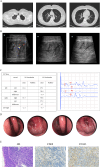Dupilumab-induced Eosinophilic Granulomatosis with Polyangiitis Complicated by Peripheral Neuropathic Pain: a Case Report and Literature Review
- PMID: 40705100
- PMCID: PMC12289772
- DOI: 10.1007/s10875-025-01914-x
Dupilumab-induced Eosinophilic Granulomatosis with Polyangiitis Complicated by Peripheral Neuropathic Pain: a Case Report and Literature Review
Abstract
Purpose: Eosinophilic Granulomatosis with Polyangiitis (EGPA) is a rare vasculitis characterized by increased eosinophils in human tissues and peripheral blood. In this case, we present a 53-year-old female patient with EGPA. By this case and literature review, we want to explain the early manifestations, diagnosis, and management of EGPA, which will help clinicians to understand the disease and attach importance to the possibility of dupilumab-induced EGPA, to improve the early diagnosis rate of EGPA, and reduce misdiagnosis and missed diagnosis.
Methods: The diagnostic criteria for EGPA established by the American Rheumatology Association (ACR) in 2022 were used; these criteria encompass clinical presentation, laboratory tests, and pathological biopsy. In addition, we conducted a comprehensive literature review on this case.
Result: We present a 53-year-old female patient who developed severe peripheral neuropathic pain after the administration of dupilumab for the treatment of refractory asthma and sinusitis. The patient's symptoms, laboratory examination findings, and nasopharyngeal biopsy pathology results collectively support the diagnosis of EGPA. When dupilumab was converted to mepolizumab combined with glucocorticoid, her peripheral neuropathic pain and asthma symptoms were dramatically relieved. Our literature review also provides a detailed discussion on the relationship between Dupilumab and EGPA.
Conclusion: We present a case of EGPA with peripheral neuropathic pain induced by Dupilumab, and mepolizumab has a good therapeutic effect on this patient. Our literature review shows that although dupilumab is effective in treating eosinophilic airway inflammatory diseases, clinicians must pay attention to the possibility of dupilumab inducing or aggravating EGPAs.
Keywords: Asthma; Dupilumab; Eosinophilic Granulomatosis with Polyangiitis (EGPA); Mepolizumab; Neuralgia; Sinusitis.
© 2025. The Author(s).
Conflict of interest statement
Declarations. Author Disclosure Statement: The authors declare that the research was conducted in the absence of any commercial or financial relationships that could be construed as a potential conflict of interest. Informed Consent: This manuscript has obtained the informed consent of the patient, and the patient agrees to publish all images, clinical data and other data contained in the manuscript. Competing interests: The authors declare no competing interests.
Figures


Similar articles
-
MPO-ANCA-positive eosinophilic granulomatosis with polyangiitis complicated by alveolar haemorrhage treated with mepolizumab as an induction therapy: Case report.Mod Rheumatol Case Rep. 2025 Jul 25;9(2):rxae088. doi: 10.1093/mrcr/rxae088. Mod Rheumatol Case Rep. 2025. PMID: 39707621
-
Mepolizumab efficacy and safety in patients with eosinophilic granulomatosis with polyangiitis in real practice: Data from a Spanish retrospective multicentric register from Rheumatology departments.Reumatol Clin (Engl Ed). 2025 Jan;21(1):101806. doi: 10.1016/j.reumae.2025.101806. Reumatol Clin (Engl Ed). 2025. PMID: 39894626
-
Two unique cases of eosinophilic granulomatosis with polyangiitis in childhood treated with anti-interleukin-5 therapy: infantile-onset and submandibular salivary gland involvement.Pediatr Rheumatol Online J. 2025 Jun 2;23(1):60. doi: 10.1186/s12969-025-01115-1. Pediatr Rheumatol Online J. 2025. PMID: 40457436 Free PMC article.
-
Burden of illness associated with eosinophilic granulomatosis with polyangiitis: a systematic literature review and meta-analysis.Clin Rheumatol. 2021 Dec;40(12):4829-4836. doi: 10.1007/s10067-021-05783-8. Epub 2021 Jun 23. Clin Rheumatol. 2021. PMID: 34159493 Free PMC article.
-
Anti-IL5/IL-5 receptor therapies for eosinophilic granulomatosis with polyangiitis: an updated Systematic Review.Front Immunol. 2025 Jul 22;16:1587158. doi: 10.3389/fimmu.2025.1587158. eCollection 2025. Front Immunol. 2025. PMID: 40766318 Free PMC article.
References
-
- White J, Dubey S. Eosinophilic granulomatosis with polyangiitis: A review. Autoimmun Rev. 2023;22(1):103219. - PubMed
-
- Fujimoto S, Watts RA, Kobayashi S, et al. Comparison of the epidemiology of anti-neutrophil cytoplasmic antibody-associated vasculitis between Japan and the U.K. Rheumatology (Oxford). 2011;50(10):1916–20. - PubMed
-
- Gonzalez-Gay MA, Garcia-Porrua C, Guerrero J, Rodriguez-Ledo P, Llorca J. The epidemiology of the primary systemic vasculitides in northwest Spain: implications of the Chapel Hill Consensus Conference definitions. Arthritis Rheum. 2003;49(3):388–93. - PubMed
-
- Reinhold-Keller E, Herlyn K, Wagner-Bastmeyer R, Gross WL. Stable incidence of primary systemic vasculitides over five years: results from the German vasculitis register. Arthritis Rheum. 2005;53(1):93–9. - PubMed
Publication types
MeSH terms
Substances
Grants and funding
LinkOut - more resources
Full Text Sources
Medical

